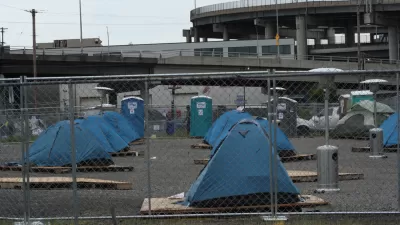A pair of articles mine the films nominated for Academy Award for lessons in design and development that could potentially benefit housing equality.

Carolina Miranda writes for the Los Angeles Times and Jenny Schuetz for Brookings, both riffing on the subject of the built environment in films nominated this year for Academy Awards.
Miranda tackles the entire crop of Best Picture nominations, starting with the "Minimalist manse inhabited by the well-to-do Park family in Bong Joon Ho’s [eventual winner] 'Parasite.'" Written before that film swept its way to a resounding and record-breaking evening, Miranda finds a common theme in each film's use of architecture to tell its story: "Taken collectively, however, the best-picture nominees deploy architecture in ways that tell compelling stories about the ways in which the poor and the wealthy divide."
Schuetz's article hones in on "Little Women" for lessons in housing development, from Schuetz's well documented pro-development perspective. So, in Schuetz's view, the lessons of the houses in the film read as follows: 1) Middle-Class Homes Do Not Drag Down Property Values of Nearby Mansions, 2) Waiving Quality Standard Allows Low-Income Families to Live in Expensive Communities, and 3) Bring Back the Urban Boarding House!
FULL STORY: How the Oscars’ best-picture nominees used architecture to tell stories of inequity

Trump Administration Could Effectively End Housing Voucher Program
Federal officials are eyeing major cuts to the Section 8 program that helps millions of low-income households pay rent.

Planetizen Federal Action Tracker
A weekly monitor of how Trump’s orders and actions are impacting planners and planning in America.

Ken Jennings Launches Transit Web Series
The Jeopardy champ wants you to ride public transit.

Rebuilding Smarter: How LA County Is Guiding Fire-Ravaged Communities Toward Resilience
Los Angeles County is leading a coordinated effort to help fire-impacted communities rebuild with resilience by providing recovery resources, promoting fire-wise design, and aligning reconstruction with broader sustainability and climate goals.

When Borders Blur: Regional Collaboration in Action
As regional challenges outgrow city boundaries, “When Borders Blur” explores how cross-jurisdictional collaboration can drive smarter, more resilient urban planning, sharing real-world lessons from thriving partnerships across North America.

Philadelphia Is Expanding its Network of Roundabouts
Roundabouts are widely shown to decrease traffic speed, reduce congestion, and improve efficiency.
Urban Design for Planners 1: Software Tools
This six-course series explores essential urban design concepts using open source software and equips planners with the tools they need to participate fully in the urban design process.
Planning for Universal Design
Learn the tools for implementing Universal Design in planning regulations.
Ada County Highway District
Clanton & Associates, Inc.
Jessamine County Fiscal Court
Institute for Housing and Urban Development Studies (IHS)
City of Grandview
Harvard GSD Executive Education
Toledo-Lucas County Plan Commissions
Salt Lake City
NYU Wagner Graduate School of Public Service





























